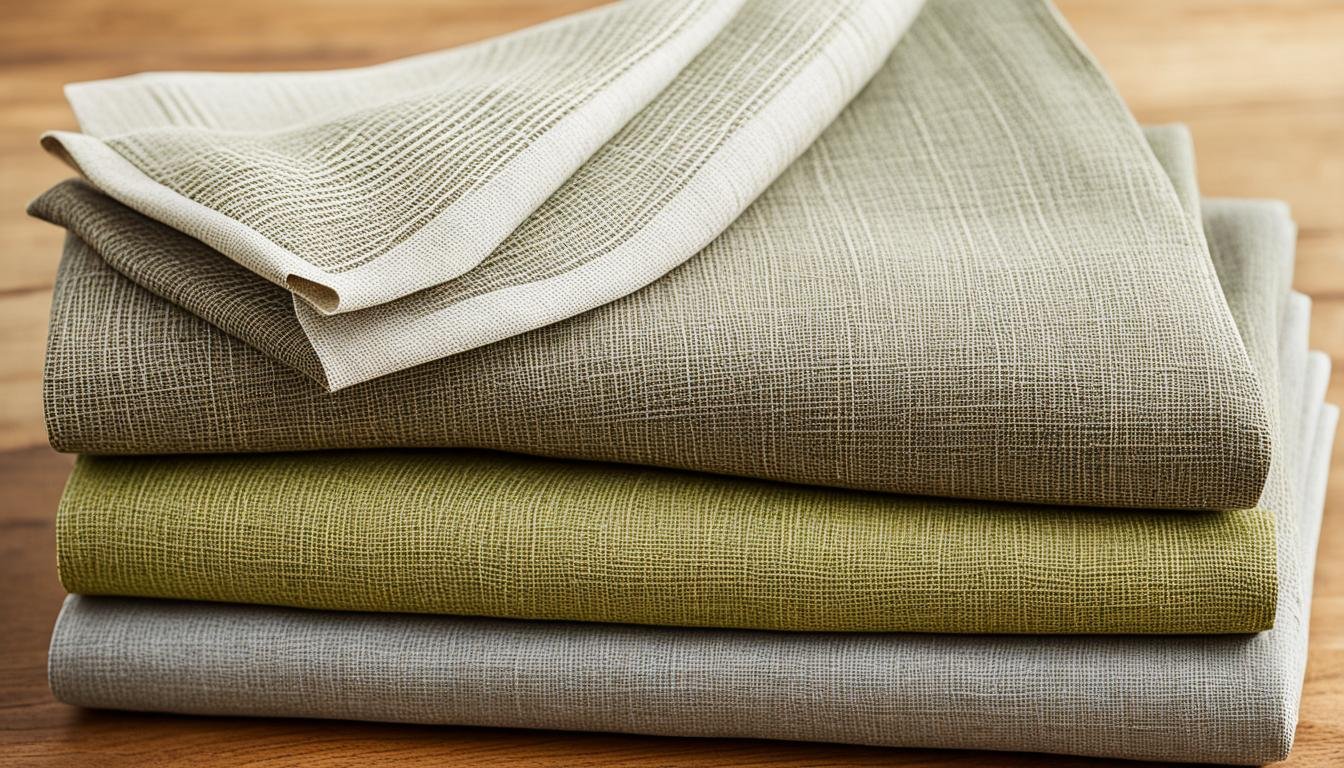Your cart is currently empty!

Exploring Uses and Benefits of Linen Fabric
Amidst a world awakening to the virtues of sustainability, linen fabric stands out as a leader in the fashion and textile industry. Cherished for its sustainable fabric qualities and myriad of other benefits, linen brings an eco-friendly elegance to the wardrobe and home. As an eco-friendly textile, linen’s advantages are manifold, providing comfort, style, and a conscience-clean experience to users worldwide.
From the arid deserts of ancient civilizations to the hustle and bustle of modern life, the versatility and durability of linen have been tested and proven. Today, linen garments are celebrated not just for their environmental credentials, but for their seamless blend into our fast-paced lifestyles, requiring minimal effort for maintenance and care. Placing eco-consciousness at the forefront, linen embodies both historical prestige and contemporary relevance, making it a paramount choice for the discerning and environmentally aware individual.
Key Takeaways
- Linen fabric is a sustainable and eco-friendly textile choice.
- The historical significance of linen adds to its appeal and trustworthiness.
- Linen garments are celebrated for their low maintenance and ease of care.
- Temperature-regulating properties make linen suitable for all-season wear.
- The environmental advantages of choosing linen are significant and impactful.
- Durability and lasting quality are foundational linen advantages.
Historical Significance and Timeless Appeal of Linen
The story of linen is as ancient as it is enduring. This historical fabric has not only served as a cornerstone of early economies, but it has also woven its way through the cultural traditions of societies across the globe. The lineage of ancient linen use stretches back to the heart of Mesopotamia and the pharaohs of Egypt, testament to its adaptation and resilience through centuries of change.
The Ancient Origins of Linen Use
In the blazing sun of the ancient world, the ancient linen use was born out of necessity. Revered for its heat-conducting and absorbent properties, linen offered a comfort unparalleled by any other textile in the warm climates of Mesopotamia and Egypt. Meticulously preserved linen found in the silence of the Egyptian tombs speaks volumes of its impeccable durability—and of a legacy that transcends time.
Linen’s Role in Cultural Traditions and Ceremonies
Linen’s significance extends beyond its practical applications, deeply entrenching itself within the cultural fabric of societies such as Lithuania, where linen has thrived for millennia. Its presence in traditional cultural traditions and rituals emphasizes its role not only as a utilitarian textile but also as a cherished emblem of a nation’s heritage and pride.
Classic Elegance: Linen in Modern Fashion
While fashion trends come and go, the timeless wardrobe element of linen continues to exude an understated elegance in modern linen fashion. Today’s designers harness the versatility and durability of linen, creating pieces that not only stand the test of time but also represent the pinnacle of eco-chic styling—breathing life into the age-old textile for contemporary audiences.
Uses and Benefits of Linen Fabric
As society becomes increasingly aware of the importance of sustainable clothing, linen fabric is stepping into the spotlight, offering a compelling suite of benefits that appeal to the eco-conscious consumer. Renowned for its moisture-wicking fabric qualities, linen offers unparalleled comfort and efficiency in dealing with humidity and heat. The following are the core attributes that make linen an indispensable part of an eco-friendly, versatile wardrobe and home.

Linen, a fabric made from the flax plant, boasts a natural luster that enhances its appeal. It exudes a quiet elegance that can be sophisticated yet effortlessly casual, depending on how it’s worn or presented. The fabric’s texture lends an organic feel to garments and home decor, striking the perfect balance between luxury and ease.
- Due to its outstanding breathability, air flows freely through the linen, which remarkably reduces overheating and provides substantial comfort during warmer seasons.
- The robustness of linen is evident in its longevity. It is touted as one of the strongest natural fibers, which translates to durable and enduring garments that not only last but improve in comfort over time, growing softer with each wash without losing integrity.
- In the realm of maintenance, this eco-friendly textile demonstrates natural anti-static qualities, warding off dust and lint, affirming its status as a practical and low-maintenance fabric.
- Linen’s inherent versatility is showcased through its adaptability. It’s not just a fabric for apparel but extends into household textiles such as bedding, curtains, and table linens, enveloping daily life in sustainable luxury.
- With its capacity to absorb dyes, linen allows for an expansive palette of shades and patterns, offering a vibrant spectrum to those who wish to enjoy its natural luster in a variety of hues.
- Choosing linen aligns with eco-conscious practices, due to its biodegradability and a production process that favors eco-friendly methodology—reducing waste and enhancing sustainability.
The comprehensive appeal of linen fabric is undeniable. Whether creating a wardrobe that traverses seasons and trends, or curating an interior space that speaks to understated elegance, linen stands as a sterling example of how sustainable clothing can be a lifestyle commitment rather than a fleeting choice.
The Health and Comfort Attributes of Linen
Amidst the myriad of textiles available, linen fabric is distinguished by its remarkable health and comfort attributes. Recognized for its hypoallergenic fabric quality, linen comforts users with sensitive skin and promotes well-being through its natural fiber composition. Beyond its aesthetic and environmental appeal, linen’s intrinsic characteristics cater to a holistic approach to health and comfort in our everyday lives.
Hypoallergenic and Skin-Friendly Qualities
For those seeking relief from skin irritations or allergies, the hypoallergenic nature of linen offers a sanctuary. Its gentle touch reduces the risk of allergic reactions and skin irritations, appealing to the most sensitive skin with its skin-friendly qualities. The composition of the fabric does not harbor allergens or bacteria; thus, it remains a steadfast ally for promoting a healthier, irritation-free experience.
Breathability and Temperature Regulation
Linen’s ability to offer thermoregulation is truly exceptional. This natural fiber actively contributes to temperature regulation, adapting to the wearer’s body temperature to provide warmth in the cold and a cooling effect during warmer months. With its remarkable breathability, linen helps maintain a comfortable body temperature throughout the day.
Linen’s Natural Resistance to Bacteria and Fungi
The anti-bacterial properties inherent to linen extend its benefits beyond simple day-to-day comfort to actively promote a healthy lifestyle. Linen’s resistance to bacteria and fungi is not just crucial for personal health but also beneficial in maintaining a cleaner and more sanitary living environment. The anti-bacterial properties of linen help in naturally repelling microorganisms, ensuring a fresh and clean experience with every use.

Conclusion
In the tapestry of sustainable fashion choices, linen fabric emerges as a profound thread, interweaving style, comfort, and an eco-conscious lifestyle. By choosing linen, consumers not only embrace a textile rich with historical significance but also take a firm stand on the side of environmental stewardship. Lithuanian linen, renowned for its superior quality and sustainable production methods, stands as a testament to the lasting linen legacy—one that continues to influence fashion and lifestyle choices around the globe.
The Lasting Impact of Choosing Linen
Opting for linen clothing and textiles extends far beyond a personal style statement; it signifies a deep commitment to conserving our planet. Linen’s environmental impact is softened through its entire lifecycle, from sustainable farming practices to minimal waste production, and ultimate biodegradability. The material’s resilience and timeless charm further ensure that it becomes a lasting staple in our wardrobes and homes, rather than a fleeting trend, thus advocating for reduced consumption and waste.
Linen’s Place in Sustainable Fashion and Eco-Friendly Living
As advocates of an eco-conscious lifestyle increasingly seek sustainable fashion choices, linen stands at the forefront, propelling the industry towards more ethical practices. Incorporating linen into one’s life—a choice reflecting both cultural homage and modern practicality—carries profound implications for our environment and well-being. The ripple effect caused by individual decisions to adopt linen could be the catalyst needed for broader changes, echoing the importance of each decision in shaping a sustainable future. Linen’s luxurious yet responsible allure endows it with the power to lead a fashion revolution, making it the fabric of choice for those who prioritize not just aesthetics, but also global awareness and ethical responsibility.
FAQ
What makes linen a sustainable fabric?
Linen is considered a sustainable fabric due to its eco-friendly production process, which requires less water than cotton, has a minimal need for pesticides, and utilizes every part of the flax plant, leading to no waste. It is also biodegradable and contributes to a reduced spread of microplastics in the environment.
Can linen garments be considered a good investment when it comes to fashion?
Yes, investing in linen garments is considered both economical and stylish. Linen offers a classic elegance that remains in style across seasons, and it becomes softer and more comfortable with each wash, often lasting a lifetime with proper care.
What historical significance does linen fabric hold?
Linen fabric has a rich historical significance, dating back to ancient Mesopotamia and Egypt. It was used for a variety of purposes, including clothing and mummification bandages in Egypt. Linen also has a strong historical presence in cultural traditions and ceremonies, as seen in its significant role in Lithuanian society and other ancient civilizations.
Why is linen fabric popular in modern fashion?
Linen fabric maintains popularity in modern fashion due to its timeless wardrobe appeal and versatility. Linen clothing is effortlessly chic, durable, and suited for a range of occasions—from casual to formal wear. Furthermore, it aligns with the growing demand for eco-friendly textile options.
What are the practical benefits of using linen in clothing and household textiles?
Linen is known for several practical benefits, including its breathability, moisture-wicking properties, durability, natural luster, and anti-static qualities. These make linen a preferred fabric for clothing and household items like bedding and curtains, as it is both comfortable and low maintenance.
How does linen fabric contribute to health and comfort?
Linen fabric is hypoallergenic and skin-friendly, making it ideal for sensitive skin or allergies. Its breathability and temperature-regulating properties provide comfort in various climates, and its natural resistance to bacteria and fungi promotes a healthier environment.
What role does linen play in promoting an eco-conscious lifestyle?
Linen plays a significant role in promoting an eco-conscious lifestyle due to its sustainable farming practices, low environmental impact, and biodegradable nature. Choosing linen products, whether in fashion or home decor, supports a legacy of sustainability and mindful consumption.
Is linen a good option for all seasons?
Absolutely, linen’s temperature-regulating properties make it suitable for all-season wear. It keeps the wearer cool in summer by allowing air circulation and is able to retain body heat in colder seasons, making it a versatile choice throughout the year.
How does linen compare to cotton in terms of environmental impact?
Linen typically has a lower environmental impact than cotton, significantly due to its more sustainable farming that uses less water and is naturally pest-resistant, which reduces pesticide use. Additionally, every part of the flax plant is used in linen production, mitigating waste.
Can people with allergies or skin irritations benefit from wearing linen?
Yes, people with allergies or skin irritations can benefit from wearing linen because of its hypoallergenic qualities. The fabric’s ability to suppress bacteria and its non-irritating nature make it suitable for those with sensitive skin.
What cultural traditions are associated with linen fabric?
Linen has been an integral part of cultural traditions and ceremonies across various societies. In Lithuania, for example, linen is symbolic and valued, featured in traditional clothing, crafts, and rituals such as the weaving of “juostos,” a type of ceremonial sash.
Can linen fabric improve sleep quality?
The breathability and moisture-wicking qualities of linen can potentially improve sleep quality by regulating body temperature and reducing discomfort from perspiration, leading to a more comfortable and restful sleep environment.
Leave a Reply